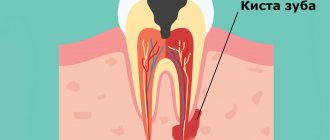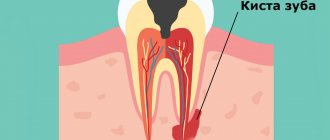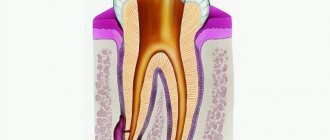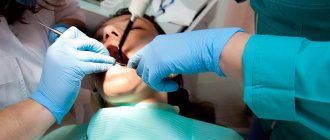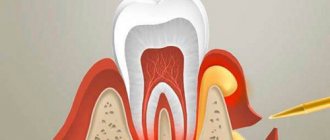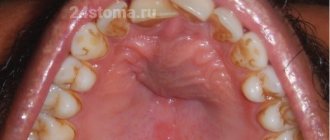Why does a dental cyst form?
The cause of cyst formation is an untreated root canal infection.
The reasons for infection in the root of a tooth can be different:
- As a complication of insufficiently treated or completely neglected
- caries/pulpitis,
- periodontitis,
- periodontal diseases,
- inflammation under the dental crown,
- Error and infection during endodontic treatment (root canal treatment).
- Tooth injury.
- Immune disorders in the body.
- Chronic diseases of the ENT organs: runny nose, sinusitis, tonsillitis.
Children in primary and mixed dentition can also suffer from dental cysts. Even newborns may experience teething with a purulent cyst - the so-called. Bona knots.
Is a tooth cyst a death sentence or not?
A dental cyst is a pathological neoplasm inside the bone tissue of the jaws as a result of the body’s defensive reaction to infection or injury. A dental cyst, as a rule, has an epithelial membrane and is filled with cystic exudate. The cyst in most cases has a chronic course and continuous growth.
A dental cyst has several stages of development: granuloma (small, less than 5 mm in diameter); cystogranuloma (up to 1 cm in diameter); cyst (more than 1 cm in diameter)
Reasons for the formation of cysts in the maxillofacial area:
- endodontic treatment of root canals . The tooth canal has more than one nerve trunk; it has many lateral branches. When treating the root canal of a tooth, infected tissue remains in these lateral micro-branches and after abturation of the canal a chronic inflammatory process can begin. Initially, a small granuloma (destruction of bone tissue) is formed, which eventually develops into a cyst. The simpler the anatomy of the root canal and the more accurately the treatment protocol for complicated caries is carried out, the lower the risk of developing cysts. In multi-rooted teeth with complex anatomy of the root system (bent, curvature, scarring, difficult access), the likelihood of developing root cysts increases significantly.
- Acute dental trauma. If a tooth has suffered trauma (impact), you should consult a doctor. Death of a nerve in a tooth or rupture of the neurovascular bundle may be invisible at first after injury and not cause concern to the patient. But such a tooth needs to be observed for several years, control x-rays taken, in which the doctor will be able to notice changes in the bone tissue in time and thereby prevent the formation of a root cyst on the root of the tooth.
- Chronic injury. There are two main reasons for this. One of them is long-term overload of the tooth as a result of missing neighboring teeth or a large number of lost teeth. This also includes occlusal supracontacts as a result of improper prosthetics or tooth treatment. The second is a vital (living) tooth covered with a crown. According to statistics, in 10% of such cases there are complications - nerve death. And if this is asymptomatic, then over time a cyst will form on the root of the tooth.
- Complications of other diseases. A root cyst of a tooth as a result of chronic sinusitis or a lateral cyst of a tooth as a result of chronic periodontitis. It is extremely rare that we encounter the formation of a cyst as a result of the transfer of infection by the bloodstream in any general somatic disease.
- Retention cyst . Cyst of an unerupted tooth. This is usually a wisdom tooth cyst. But cysts of other impacted teeth also occur.
- Residual cyst. The remaining cyst after tooth extraction. It can also increase in size and can lead to an inflammatory process. And most importantly, in the presence of such a cyst, it is not possible to carry out two-stage dental implantation.
Clinical symptoms of a dental cyst
- Asymptomatic. The course can last for years. The patient does not notice anything at all and nothing bothers him. The cyst is discovered by chance during an X-ray examination
- Chronic course. The patient can palpate (with his finger) the formation of some kind of tubercle in the area of the apex of the tooth root; discomfort when pressing; slight redness or minor pain symptoms that periodically make themselves felt. When visiting a doctor and R-graphic examination, the presence of a cyst in this area is determined.
- Acute course. With an exacerbation of the chronic process, the cyst suppurates and pain, swelling, redness, temperature, and general malaise appear. Pain appears when pressing on the causative tooth, which intensifies with chewing. A fistulous tract may form in the area of the root apex. Regional lymph nodes are involved in the process.
Consequences of an untreated dental cyst
The consequences of a cyst include, first of all, the likelihood of its exacerbation and the development of periostitis, purulent abscess or osteomyelitis. Inflammation of the cyst is quite pronounced and often ends with tooth extraction and can lead to short-term disability. If the patient at this stage does not consult a doctor and does not receive qualified dental care, sepsis may develop. This is an extremely serious condition, characterized by infection entering the blood and spreading throughout the body.
As a result of an asymptomatic course, the cyst gradually increases in size, destruction (destruction) of the bone tissue around the tooth occurs. The cyst can reach several centimeters in diameter and in this case the likelihood of complications is very high.
Here, for example, are some complications of an overgrown cyst:
- destruction of the bottom of the maxillary sinus, germination into it and, as a result, sinusitis.
- destruction of the cortical plate of the alveolar process and, as a consequence, the formation of a fistulous tract and the impossibility of installing an implant subsequently.
- growth of the cyst into the canal of the mandibular nerve, leading to neuritis.
- the growth of a cyst on the lower jaw can lead to a pathological fracture of the jaw.
- the growth of the cyst leads to the involvement of the roots of neighboring teeth in the pathological process and, as a result, their removal (removal of completely healthy teeth!)
Treatment methods for dental cysts
1. Conservative treatment
This type of treatment allows you to save the tooth. The dentist creates access to the root canal of the tooth, opens it and cleans it. Since the apex of the tooth is connected to the root cyst, the contents of the cyst emerge from the canal. After antiseptic and mechanical treatment of the root canal, it is filled with special calcium-containing pastes. Treatment lasts from 1 to 6 months, depending on objective data and the patient’s ability to visit a doctor.
Only after 6 months, on a repeated R-graph of the tooth, one can see the regeneration of bone tissue, the formation of bone balls in the area of the cyst and say with confidence about the success of the conservative method.
In our Euro Dentistry clinic, dental therapists have extensive experience in treating dental cysts using a conservative method, have a large percentage of cases of successful bone tissue regeneration, and fight for each tooth together with the patient. Only in the most critical cases do they abandon this method and send the tooth for extraction.
2.Surgery.
Here, too, not everything is clear. There are several methods of surgical treatment of root cysts. These are:
— Cystectomy operation with resection of the root apex. This is the removal of the cyst and part of the damaged root. The method is highly effective, but is quite complex and requires highly qualified specialists.
- Hemisection. In this case, one root is removed from a multi-rooted tooth. The doctor removes the cyst, the damaged root and part of the tooth crown, and the tooth is covered with a crown. The method is less effective, complex and unpredictable.
- Removal of a tooth. It is carried out with the obligatory removal of the cyst capsule to avoid relapse.
At Euro Dentistry in Vitebsk, after examining the patient, clinic specialists will make a final diagnosis and offer the best treatment option for the dental cyst. A cystectomy or tooth extraction along with a cyst will be performed without pain.
What are dental cysts?
Clinic doctors
A jaw cyst is an inflammation characterized by the formation of capsules with a dense shell. Dental cyst removal is carried out in our clinic. The reason for the appearance of a cyst is the penetration of pathogenic microorganisms into the tissue. For a long time, the disease can be asymptomatic, but in an advanced state it can lead to serious complications (fistula in the gums, etc.). Previously, to get rid of a cyst, it was necessary to remove a tooth. Today, tooth-preserving operations are carried out to completely get rid of the disease.
What is a dental cyst (granuloma). Types of cysts?
Granuloma, cystogranuloma and dental cyst are successive stages in the development of the inflammatory process:
- Granuloma consists of granulation tissue, which is enclosed in a capsule. It forms around the apex of the root and looks like a sac with a diameter of about 0.5 cm.
- Cystogranuloma is slightly larger. It forms when inflammatory fluid (exudate) begins to accumulate inside the granuloma.
- A dental cyst is a tumor-like formation, a kind of chamber filled with exudate, which contains toxins produced by microbes.
Depending on the etiology and location, two types of cysts are distinguished: radicular (formed near the root of the tooth) and follicular (appears near the developing tooth).
What are the indications for removing a tooth cyst (granuloma)?
The cyst must be removed if it has reached a large size, since over time the entire tooth may fall into its cavity, and then it will have to be removed. Also, an indication for cyst removal is its presence on baby teeth.
What are the contraindications?
The patient has cardiovascular diseases, mental disorders, blood diseases, acute infectious diseases, as well as malignant tumors. In addition, pregnancy at 1, 2 and 9 months is a contraindication.
How is diagnosis carried out before surgery?
Before an operation to remove a dental cyst, the question arises not only about preserving the causative tooth, but also about whether the apex of the root of an adjacent tooth with a healthy pulp enters the cystic cavity. It should also be taken into account that during surgery, nerves and blood vessels in the periapical region of adjacent teeth can be damaged. If this happens, death of their pulp will follow after the operation. X-rays do not always provide a reliable answer to these questions, so you have to resort to computed tomography.
What difficulties hinder the operation?
Removal of granulomas and cysts on the upper jaw is difficult due to the proximity of the maxillary sinus. Because of this, a complication such as perforation of the maxillary cavity may arise during the operation. Surgical intervention on the lower jaw is complicated by the proximity of the mandibular canal, which contains blood vessels and nerves. The slightest damage to them can cause pain and loss of sensitivity in the gums, lips, cheeks or tongue.
What is the surgical procedure for removing a dental cyst? Types of operations.
The cyst can be removed using different surgical methods:
- Cystotomy. The purpose of the operation is to remove large cysts. The essence of the operation is to remove fluid or pus from the neoplasm, treat the cyst and use antibacterial agents to break down its membrane. This method implies that if the cyst gradually decreases in size, the growing bone tissue will fill the vacant space.
- Cystectomy. Complete removal of the cyst with resection of the tooth root. The gum is cut, the apex of the root is cut off with a drill, the resulting cavity is filled with bone-forming material, after which the wound is sutured.
- Hemisection. The operation is performed on multi-rooted teeth. In this case, not only the cyst or granuloma is removed, but also one of the roots - partially or together with the coronal part.
What are the possible complications?
When removing the apex of a tooth root that has fallen into a cystic cavity, trauma to the tooth may occur, which can lead to its loss. During curettage, damage to the vessels leading to the pulp of a healthy tooth located next to the cyst is possible - this will lead to the death of the pulp.
What are the recommendations in the postoperative period?
Immediately after the operation, you must refrain from hot and cold foods, smoking, and alcohol. For fever and severe pain, antibiotics and analgesics are recommended. To speed up healing, you need to rinse your mouth with antiseptic solutions. If fever and pain persist for a long time, you should definitely consult a doctor.
What are the quality criteria for removing a dental cyst?
In most cases, after surgery, the patient can forget about the cyst forever. Confirmation of quality will be the absence of a tumor on an x-ray. However, in some cases, the cyst may reappear - if such relapses occur, you must regularly visit the dentist for a follow-up examination.
How much does it cost to remove a dental cyst?
The cost of such an operation depends on the size of the cyst, the chosen technique and the complexity of the case. The sooner the patient sees a doctor, the cheaper the operation will cost him. A detailed calculation is possible only after a doctor’s examination and x-ray examination.
Why do you need to remove the cyst?
If a dental cyst is not removed in time, even with an asymptomatic course of the disease, the consequences can be very serious - this is a real “time bomb”.
- The main danger of a cyst is that sooner or later it will destroy the affected tooth, and then “get” to the neighboring teeth.
- Cysts are reborn. Slowly but surely, so in 15-20 years it may already be a malignant formation.
- An infection is raging in the cavity of the cyst, so with a general illness, hypothermia, or a decrease in immunity as a result of simple stress, acute purulent inflammation is possible - flux, abscess, phlegmon.
- The infection can spread to adjacent lymph nodes and cause inflammation - lymphadenitis.
- Gradual thinning of the jaw bone in the affected area, due to purulent melting, turns into osteomyelitis. Even a spontaneous fracture of the jaw is possible.
- The cyst enlarges and can grow into the nasal cavity or maxillary sinus.
- Infection in the cyst can cause sepsis, a blood poisoning.
If treatment is not started on time, the tooth will have to be removed. And this is the minimum “evil”.
What are the symptoms of a dental cyst?
For a long time, the cyst may not manifest itself in any way until it becomes large enough in size, so it is very rare that a cyst is diagnosed at an early stage of the disease. This mostly occurs accidentally when the patient is having an x-ray for another reason.
At a later stage, the patient begins to worry about:
- Aching pain that gets worse over time. Such pain is difficult to relieve with regular painkillers.
- Pain when biting.
- Swelling of the gums and/or cheeks.
- An abscess, gumboil, or fistula may form on the gum.
- General malaise, fever.
How is a dental cyst treated?
The first thing that should be said is that today a dental cyst is successfully treated with a high percentage of preservation of the affected tooth, although in the past the diagnosis of a “cyst” meant 100% removal.
There are 2 main approaches to treatment:
- Therapeutic. Therapeutic treatment of dental cysts is used when
- There is access to the dental canal through the dental crown
- The canals are not sealed or can be opened
This method of treatment is very similar to the treatment of periodontitis, with the only difference being that the doctor additionally removes pus from the cyst cavity and injects special medicinal preparations into the root canal.
This treatment takes at least 1-2 visits, is carried out under sterile conditions, using a rubber dam and a dental microscope, because requires special care from the doctor to prevent relapses.
Treatment of cysts with laser with access through the coronal part of the tooth is another type of therapeutic treatment. Its main difference is that the laser immediately completely disinfects the area of the removed cyst, the treatment is quick and bloodless, the disadvantages include the risk of burns.
There are several methods for surgical removal of cysts, but cystectomy - complete removal of the cyst with all its contents - is the most modern and most effective of them.
Cystectomy is indicated for:
- A sealed root canal that is difficult to open.
- The affected tooth is replaced with a crown
- Pain, swelling of the cheeks/gums.
Is bone grafting necessary after cyst removal?
The decision on the need for bone grafting after treatment of a dental cyst is made by the dentist on an individual basis. If conservative treatment of the disease was carried out, and the affected tooth is preserved, then surgical manipulation is usually not required. When examining the oral cavity, a slight deficiency of bone tissue will be noted, but it will recover on its own within some time after recovery.
If the cystic formation reaches a large size, then the patient will experience a significant lack of his own bone tissue. Indications for osteoplasty do not depend on the preservation or removal of the affected tooth. The only thing that matters is the number of missing jaw bone cells.
In advanced situations, when treatment of a cyst required tooth extraction, and the bone deficiency is so severe that it is dangerous for the patient to apply any physical stress to the jaw, consultation and assistance from an oral maxillofacial surgeon is required. Proper surgical intervention in such a situation becomes especially important, since the future functionality of the jaw as a whole and the possibility of installing implants with crowns depend on it.
How is surgery to remove a cyst (cystectomy) performed?
Removal of the cyst is carried out by a dental surgeon in a surgical office, on an outpatient basis, the operation usually lasts about half an hour, an hour after the manipulation the patient can go home. Improvement in the patient's condition should occur 6-8 hours after the operation. A sick leave certificate is issued for the recovery period - until the stitches are removed.
To relieve all pain, the patient is given local conduction or infiltration anesthesia; we also numb the injection site with an application gel. After surgery, painkillers in tablets are prescribed for the first time.
I Preparatory stage
- The patient is diagnosed by a surgeon, and a consultation with the attending dentist-therapist is required.
- It is advisable, if the operation is not urgent, to provide the patient with professional hygiene and sanitation of the oral cavity before surgery - this reduces the presence of infection in the oral cavity and healing proceeds faster.
II Carrying out the operation
- The patient is given anesthesia.
- The surgical field is treated with an antiseptic.
- The dentist-surgeon separates the mucoperiosteal flap from the bone.
- Access to the affected area is provided, the cyst along with the affected part of the apex of the tooth is removed.
- The cavity is thoroughly cleaned and washed with an antiseptic.
- An antiseptic is injected into the cavity and the wound is sutured.
- During the recovery process, the cavity heals on its own and the bone tissue is restored.
III Postoperative period
- After the operation, you should not eat for 4 hours, then the food should not be hot, liquid and gentle.
- The patient is prescribed antibiotics to fight the infection and painkillers.
- Hygiene can be carried out according to the standard scheme one day after surgery, according to the recommendations of your doctor.
- Antiseptic rinses and healing gels are prescribed.
- Swelling of the gums and face may occur for several days.
- NOT RECOMMENDED:
- Warm the surgical site, because re-development of the infection is possible.
- Take medications without a doctor's prescription.
How is a front tooth cyst removed?
What to do with a front tooth cyst when therapeutic methods have not brought any effect? In such a situation, surgical removal is indicated. Since the front teeth have only one root, it will not be possible to get rid of the affected half - the aesthetics will be affected, and most importantly, the problematic tooth will soon break and will have to be removed.
The most popular and adequate way to remove a front tooth cyst is cystectomy. It is most appropriate on the front teeth, since it allows you to gain access to the cystic cavity without much difficulty. Under local anesthesia, damaged gingival and dental tissues are removed, and resection is performed (cutting off the root apex). After the operation, the tooth continues to function fully. There is a 100% guarantee of recovery with this treatment.
Despite the fact that the cyst initially functions as a protective mechanism, it works “for good” only up to a certain point. Without proper attention, the disease can lead to serious health problems. And in the case of a front tooth cyst, you need to go to a specialist immediately, since its development, due to the structural features of the front teeth, occurs much faster. To maintain dental health, make it a rule to visit a specialist twice a year - a cyst does not appear suddenly, it grows and forms over a long time, so regular examination will help stop the pathological process. If the symptoms of a front tooth cyst have already appeared, under no circumstances should you get carried away with painkillers or self-medication. The sooner you contact a professional, the easier and more successfully you will be able to get rid of the disease.
Prevention of dental cysts
Taking standard care of your dental and general health will help prevent the development of cysts.
To prevent dental cysts from bothering you, you must:
- Undergo regular preventive examinations with your dentist every 6 months and a professional hygiene procedure. Do not refuse if the doctor offers you an X-ray examination - he has reasons for this.
- Treat caries and pulpitis in a timely manner.
- To identify hidden caries at an early stage of the disease, for this in our clinic we use digital (not x-ray) diagnostics using the Diagnocam apparatus. We recommend undergoing such diagnostics at least once every six months.
- Brush your teeth well yourself using dental floss, irrigator, and mouthwash. Pay attention to cleaning your tongue.
- Strengthen immunity.
Price for tooth cyst removal
The cost of surgery to remove a dental cyst depends on the location and size of the cyst, as well as the chosen method and the severity of the case. In our clinic you will receive qualified assistance at prices quite affordable for Moscow:
- Cystotomy - 3,000 rubles.
- Hemisection - 2,200 rubles.
- Cystectomy - 7,000 rubles.
The indicated prices are indicative; detailed calculations are possible only after an appointment and examination with a doctor. Remember, the sooner the patient goes to the clinic, the easier and cheaper the treatment will be.
